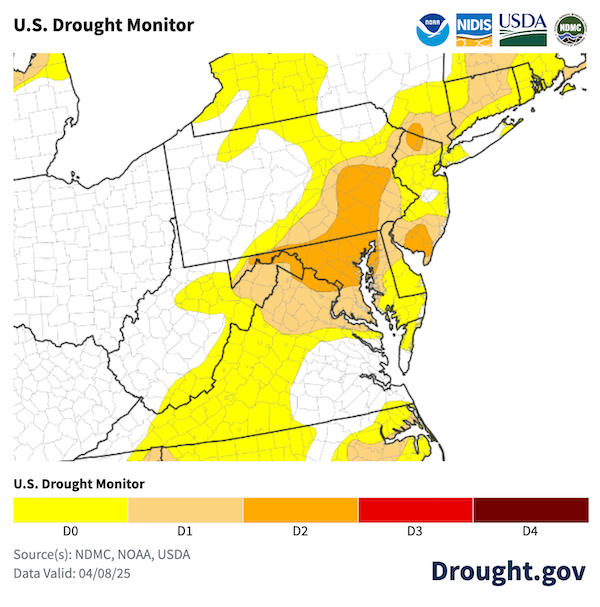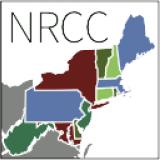For the latest forecasts and critical weather information, visit weather.gov.
Building Drought Early Warning Capacity in the Mid-Atlantic
In 2024, heat and a lack of rainfall led to widespread drought across the Mid-Atlantic states (Delaware, Maryland, New Jersey, Pennsylvania, Virginia, West Virginia, and the District of Columbia). For some locations, this was the worst drought the region experienced in more than two decades.
NOAA’s National Integrated Drought Information System (NIDIS), Northeast Regional Climate Center (NRCC), NOAA’s Regional Climate Services Eastern Region, state climatologists, watershed organizations, and other partners recently hosted a series of meetings to capture the experiences of drought in 2024 and 2025 across sectors, as well as the gaps, needs, and potential next steps for greater regional drought early warning capacity.
During the meetings, participants from state agencies, local government, water utilities, academia, and non-profits shared how they were impacted by the drought and information gaps they experienced. In a follow up meeting, participants reflected on these impacts to identify possible next steps to better prepare for future droughts in the Mid-Atlantic.
The information gathered in the meetings will inform a 2024-2025 Mid-Atlantic Drought Assessment.
Drought’s Evolution in the Mid-Atlantic
Drought arrived in the region in the summer of 2024 amid warm temperatures and a lack of summer rainfall. Temperatures were warmer than average across the entire region from June through November. June and July 2024 brought well-below normal precipitation in much of the region. After a brief respite from dry weather in August, much of the region received precipitation that was 25-50% of normal in September and October 2024. Winter brought cooler temperatures to the region, though all but southern Virginia and West Virginia continued to see below-normal precipitation.
At the end of March 2025, many areas had not fully recovered from drought with low snowpack, low streamflow, and below-normal groundwater levels. As of April 8, Moderate or Severe Drought (D1-D2) is still present in each of the mid-Atlantic states (Delaware, Maryland, New Jersey, Pennsylvania, Virginia, West Virginia, and the District of Columbia).

Looking ahead, drought and Abnormal Dryness (D0) are forecast to remain in parts of Pennsylvania, Maryland, Virginia, and West Virginia, according to the National Weather Service Climate Prediction Center. Conditions are favored to improve in eastern and coastal areas of the region currently in drought.
Assessing Drought in the Mid-Atlantic
To understand how drought impacted communities in the Mid-Atlantic, meeting organizers asked participants to share how the drought affected them. Agricultural impacts included reduced crop yields of hay, cranberry, and other crops; livestock losses due to disease; increased need for irrigation; and economic impacts to farms and agricultural businesses. Drought harmed human health in the region too: wildfire smoke reduced air quality for some communities, and public health agencies attributed an increase in bee stings to drought conditions.
Drought almost cancelled a celebration of American history in New Jersey and Pennsylvania: low levels on the Delaware River threatened to cancel a reenactment of George Washington’s December 24 crossing of the Delaware River out of concern that actors would not be able to put in at the dock, or that the boat used in the crossing could become stuck. Low water levels also reduced sport fishing, whitewater rafting, tubing, and other water-based recreation in the region, while harmful algal blooms further reduced access to recreational lakes. Ecosystems were also negatively impacted, as reduced reservoir releases, low streamflows, and warm water temperatures harmed aquatic habitats.
Participants also highlighted information and resources that would be helpful to have during the next drought: real-time groundwater, soil moisture, and water supply storage information; impact reporting to better document the harm caused by drought; precipitation, streamflow, and drought amelioration forecasts; and better coordination and best practices shared across the region.
Moving Forward
In a follow up session, attendees identified potential next steps toward improved drought early warning capacity in the region. Some of these priorities included:
- Regular collaboration opportunities between state and local agencies to share timely and relevant drought information.
- Regional understanding of drought impacts and decision timelines across sectors to inform drought warning stages in Mid-Atlantic watersheds.
- Development of a timely and relevant drought data dashboard tailored for the Mid-Atlantic region.
- Creation of sharable graphic templates for public-facing drought updates.
- Trainings (in-person or virtual) on the application of drought indices such as the Evaporative Drought Demand Index (EDDI), Palmer Drought Severity Index (PDSI), Standardized Precipitation Index (SPI), and Keetch-Byram Drought Index (KBDI) for drought decision-making.
- Access to tools for flash drought early warning and development, groundwater data, and historical drought information that includes analog drought events.
A core outcome of these meetings is the 2024-2025 Mid-Atlantic Drought Assessment, expected to be available this summer. Together, the feedback shared by meeting participants will help to inform next steps among engaged partners to build drought early warning capacity and resilience in the Mid-Atlantic region.








